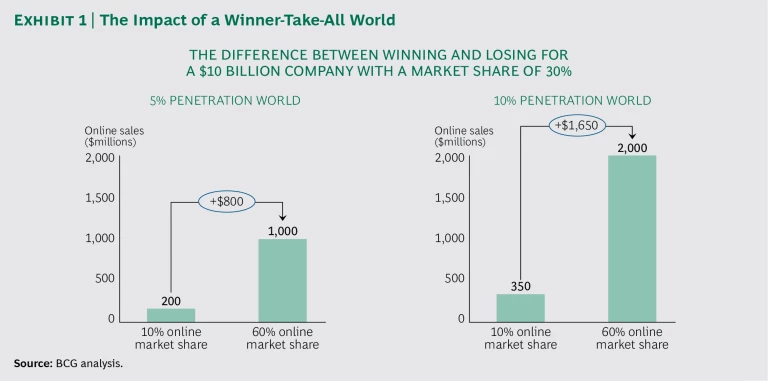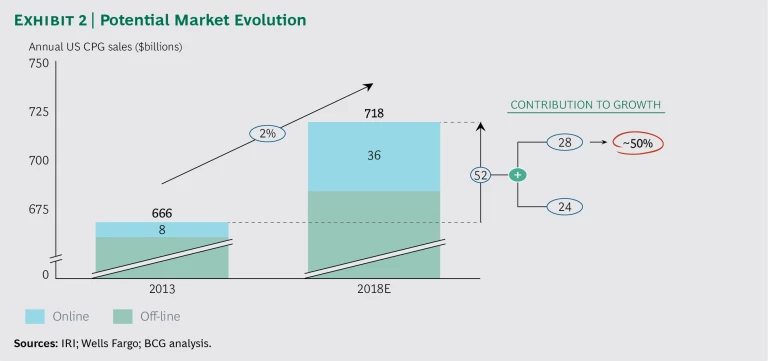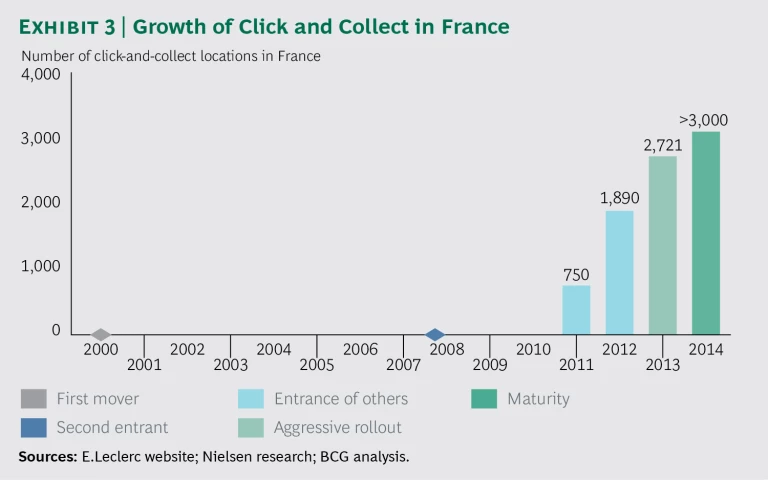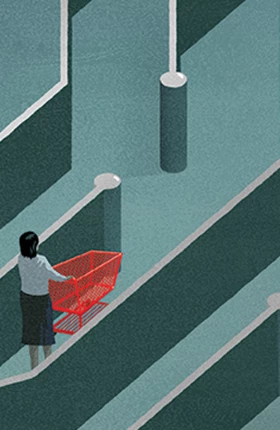Many companies do not realize it yet, but the consumer packaged goods (CPG) industry is facing a winner-take-all world. A world in which about half of all growth is online (more in certain categories and markets), brick-and-mortar market share and shelf-space prominence do not translate into digital sales, and nimble new competitors with disruptive strategies (as well as a few established players) stake out leadership positions and are then hard to dislodge. A world in which long-standing retail relationships are upended and new retail sales models take hold. In which companies have to earn their market positions with very different approaches and skills.
In this rapidly transforming world, the difference between winning and losing for a $10 billion company with a 30% brick-and-mortar market share could reasonably reach $1.65 billion—approaching 20% of sales. (See Exhibit 1.) A winner-take-all world.
In 2014, BCG published a report about how CPG companies needed to plan for a “1-5-10” market in the US over the subsequent five years. (See “About This Report.”) In this market, the 1% penetration rate of e-commerce will most likely expand to 5% but could quickly accelerate to 10%—or even more in certain categories and locations. The most likely sector-wide scenario is for e-commerce in the US to average 5% of the mix by 2018, or some $36 billion in annual sales, which would represent about half of total expected CPG sector growth. (See Exhibit 2.) As a result, companies without effective digital capabilities risk stagnation, share loss, or, in some categories, shrinking sales. At 10% penetration it’s an entirely new paradigm. A little more than one year after that report, not only is the industry well on track, but penetration is accelerating.
ABOUT THIS REPORT
This report is the first in a series of publications to be produced in the coming months by BCG and the Grocery Manufacturers Association (GMA) on the winner-take-all world in consumer packaged goods (CPG). The series builds on the work done for the report The Digital Future: A Game Plan for Consumer Packaged Goods, produced by BCG, the GMA, Google, and IRI (August 2014). The series will look in-depth at the coming changes in the consumer goods sector and present potential strategies in multiple areas that CPG companies can pursue in response. These areas are gaining “digital shelf space” prominence; winning with Amazon; developing the capabilities for click and collect; mastering other new retail models; and leadership in the digital age. The series is based on research conducted collaboratively by BCG and the GMA as well as BCG client experience. The results have been discussed with executives from GMA member companies, but BCG is wholly responsible for all analyses, conclusions, and recommendations.
A Different Digital Drummer
This new, winner-take-all digital world is being shaped by four factors. First, while multiple business models are emerging, a few are disproportionately influential. Second, the game is increasingly played by new rules requiring very new skills. Third, early-adopter consumers are already settling into patterns of digital buying behavior. Fourth, and most important, success breeds exponential success.
Influential Digital Business Models. The new digital world is both different and significantly more complex than the traditional brick-and-mortar retail industry. There are now myriad variations and permutations in all phases of the business—including product offerings, the ways in which products are sold and bought, and companies’ interactions with consumers. Consumers move seamlessly back and forth between digital and traditional channels, often mixing the two: ordering from Amazon on their smartphones while standing in a store, for example. New business models are rapidly proliferating and will continue to evolve.
All that said, the various Amazon e-commerce models (starting with home delivery, but also including Prime, Prime Pantry, Prime Now, and AmazonFresh) are by far the most influential with regard to consumers and how they shop in the US today. This is primarily because of the breadth of Amazon’s offerings and the complementary role that search plays during the shopping process. Yet numerous other business models—for example, that of aggregators such as Instacart that serve as intermediaries between consumers and brick-and-mortar retailers—are also gaining in importance. In our view, the most important and most disruptive for many CPG categories will be the click-and-collect model, under which consumers order online or on their smartphones and pick up their groceries at a store, a dedicated facility, or a locker later in the day. Click and collect has proved popular in other markets, such as France and the UK, and it is a powerful fit with the automotive mobility of US consumers, especially those for whom time constraints are a perpetual pressure as they juggle the demands of jobs and families. In many instances, these services will be offered by brick-and-mortar retailers, since click and collect is the best way for these retailers to leverage their existing infrastructure for competitive advantage. But for plenty of categories in the US today, the initial game is won or lost by the results that appear on the first page of a search on Amazon, given that many digital consumers never look any further.
New Rules, New Skills. A large brick-and-mortar market share does not guarantee online sales. And the skills and capabilities that build big shares in traditional channels—such as mass-media brand building, traditional-packaging design expertise, retailer relationship development, shelf management and optimization, and supply chain management—don’t have the same impact online. Digital skills include digital-media targeting, online-content management, social-media shaping, search engine optimization, mobile advertising and app development, and optimizing packaging and the supply chain for individual-unit picking and home delivery or locker storage.
In the winner-take-all world, these skills are not only requirements but also the new differentiators. Smaller companies (such as Kind and Annie’s Homegrown) and more agile competitors (such as L’Oréal) have been quick to build such skills—and to take significant digital market share in key formats, including Amazon, as a result. For example, a search for the top five grocery brands on Amazon in March and October of last year found that none belonged to major CPG manufacturers in March, and only two did in October. Only one major CPG dog-food brand ranked among the top five Amazon sellers in both months.
Digital Buying Behaviors. Digital channels have opened up a plethora of new options that consumers have enthusiastically explored—and embraced. Amazon reported that nearly 60% of its customers shopped using a mobile device during the 2015 holiday season. Target said that mobile traffic made up 60% of Target.com traffic from November through December of 2015. Early adopters are now making decisions about which models and services they like and want to integrate into their daily lives and routines, even as they continue to experiment with new innovations. This pattern of exploring widely then settling down has been evident in other sectors disrupted by digital innovation. One example is travel, in which frequent travelers checked out multiple online travel agencies, such as Orbitz and Travelocity, and metasearch offerings (online tools, such as Kayak.com, that use other search engines’ results) before gravitating toward a few long-term winners, such as Expedia in the US (although start-ups continue to explore new avenues of disruption).
In the grocery sector, more and more consumers are locking into online subscription services, such as Amazon Subscribe & Save, for regularly purchased items. (Amazon’s estimated share of the online grocery market rose from 24% in 2012 to 29% in 2014.) Consumers often start with informational searches on a relatively small subset of e-commerce sites, typically including Amazon, then make purchases from online retailers whose pricing and quality of product and delivery they have come to trust. Convenience and emerging habits are the biggest drivers of Amazon’s business.
Millions of consumers have committed to platforms that charge annual membership fees in return for free shipping and other benefits, such as access to streaming music or video. Amazon has some 41 million Prime members—35% of US households. Factors such as urban density and income certainly come into play, and many of these shoppers might still try other options from time to time, but once they lock in, the barriers to actually switching—in terms of money, effort, familiarity, and habit—can be high. A social-media counterpart is Facebook, which wins by being the primary, but not necessarily the exclusive, social network in people’s lives.
Success Breeds Exponential Success. Search engines serve up results that are broadly based on keyword relevance and user popularity. First-page search results on e-commerce sites such as Amazon are typically based on keyword relevance and actual sales. Because of the ways that most search-engine algorithms work, and the predilection of many consumers to follow the trail blazed by early adopters, brands that are fast and aggressive online often establish positions that are stronger than those of their slower competitors—frequently much stronger than could ever be achieved in traditional retail environments. In the traditional retail environment, companies with deep pockets seek to dislodge competitors by buying their way to greater sales with new product placements, prominent shelf displays, and potent consumer promotions. Such deep-pocketed promotional allowances and campaigns are sometimes impossible to conduct in an e-commerce environment. And even when they can be implemented, they do not have the same kind of impact. Research has shown that the items that appear on first-page product searches have very low rates of churn.
As a result of each of these factors (among others), the companies, brands, and products that are winning in digital are winning big—disproportionally big—and often at the expense of traditional retail leaders. In the winner-take-all digital game, companies that assume their 20% off-line share will translate to a 20% online share are playing to lose. Winners get in early, with strategies and campaigns designed for digital, and they make the often-significant investments necessary to grab share and build an early lead. They stay out front and frequently increase their leads because sales rankings and e-commerce algorithms are self-reinforcing. Slower competitors are relegated to also-rans, a position from which it is hard to catch up. Companies either win big or lose big—and the consequences, because of the relative pace of CPG growth both online and off-line, are massive.
Major CPG players essentially need to start from scratch in digital commerce against a host of competitors, many of which have never even shown up on the brick-and-mortar radar screen. It’s a fundamentally different competitive set, and even the small companies—such as Kind, Keurig Green Mountain, and Annie’s Homegrown—can be massive disruptors. In category after category, many such new competitors have already discovered how to win and have created substantial leads.
Traditional CPG companies must first determine how to catch up online—no easy feat—and then figure out how to integrate their digital and traditional operations, which is the only way to ensure continued growth over the medium-to-long term.
Six Game Plans for Winning in a Winner-Take-All World
In our 2014 report, we observed that a series of low-risk, no-regret moves can help any company in the near term to better prepare for a 1-5-10 world. These moves include developing an integrated strategy, revisiting category management by channel, rethinking supply chain configuration, and building an adaptive organization. But by themselves these measures are not enough. While they can put a company in a better starting position, they will not result in the disproportionate gains in share that are required to win. As the pace of change accelerates and first-mover advantages solidify, companies that want to win will need to quickly take six actions, as outlined below. We will explore a number of these more specifically in subsequent publications.
Gain Shelf-Space Prominence. Digital experts often talk about the limitless choice and variety that e-commerce provides consumers, but this thinking leads to the wrong conclusion. While the number of available SKUs is theoretically endless, in the real world of the shopper, the far more relevant consideration is the number of choices most shoppers actually see and the purchases they actually make. A shopper pushing his or her cart down a long supermarket or discount-store aisle passes dozens of big brand and product displays grouped for visual impact. In the store, CPG companies exercise lots of control over where and how their brands are presented. But an online search for a particular product—toothpaste, say, or coffee—results in three to six choices on a computer screen on the first view; on a smartphone, such a search typically returns three. How many people scroll down to see more? In an average Google search, the results on the first page receive 94% of all clicks, and the top five results get two-thirds of all clicks.
The SKU selection may be endless, but the amount of “digital shelf space” the consumer actually sees or uses is highly constrained. And, unlike in a store, this shelf space is driven by algorithms or sales performance—on that website or app—that can’t be bought. For CPG brands online, out of sight means out of mind. And companies have much less control over where and how their products are displayed.
Moreover, not only is digital shelf space limited, but the leading product positions are also highly “sticky.” It’s very hard to move from lower in the rankings up to the first page, and results at the top have a big advantage—their position drives an even greater volume of sales as well as clicks, leading to self-fulfilling reinforcement of digital shelf-space position. For CPG manufacturers, entrenching their products on the first page is critical, but getting there is a fundamentally different game than winning shelf space in a brick-and-mortar store. CPG companies need to understand how the drivers of each retailer’s unique, complex algorithm can be influenced through manufacturer activity, and in turn focus their marketing and sales efforts on influencing those drivers.
Create a Strategy for Amazon. Just about every CPG company needs a strategy for working with Amazon, which has very different goals and operates by very different processes than manufacturers’ traditional retail partners. Amazon’s objective is to gain more and more share of total household spending by offering optimal prices, selection, and convenience, and it is highly sophisticated in managing both product and total manufacturer profitability. Amazon continually pilots and rolls out new models and services—including Amazon Prime, Prime Now, Prime Pantry, Amazon Subscribe & Save, and AmazonFresh—several of which take direct aim at disrupting traditional CPG sales models. The online retailer is going after multiple brick-and-mortar formats, from club to convenience. At the same time, Amazon’s operating model serves to reduce the importance of direct manufacturer interaction and engagement. The model is data driven and designed to put the consumer first; it functions in a way that is essentially the antithesis of the personalized account-management approach that has long been the CPG industry standard. The company also provides relatively few points of contact for most vendors. And scale provides fewer benefits to manufacturers in terms of bargaining power.
Nevertheless, CPG companies can take steps to improve their situation. One is to develop the right assortment strategy. Another is to get content management—such as imagery and product information—and service levels right. Service level performance is a key factor in consumers’ evaluation of Amazon and is therefore also key in Amazon’s evaluation of its suppliers and potential partners.
Amazon offers a few of its own opportunities as well. The company’s Strategic Vendor Services provides one way for large CPG manufacturers to build dedicated relationships within Amazon. CPG manufacturers can also use their expertise to support the expansion and development of Amazon’s grocery business. They can leverage their logistical capabilities to help Amazon build out its newer concepts, such as Prime Pantry, and up-and-coming business models, such as AmazonFresh. Amazon continually experiments and refines its business models and offerings; working closely with the company can help secure significant first-mover advantages as Amazon explores multiple avenues in its effort to become the top retail destination in the US and the world.
To be successful, however, CPG companies need to reorient themselves with regard to how Amazon and other online merchants work. For example, CPG manufacturers need to put a priority on achieving high first-page rankings for their brands and products by employing search-engine-optimization techniques, creating top product content, and continuously building good consumer reviews. They also need to rethink packaging and innovation for e-commerce and adapt their supply chain to keep up with Amazon’s expansion.
Develop the Capabilities for Click and Collect. Online grocery shopping, especially via click and collect, is catching on in the US—and with good reason: consumers love the idea. Grocers’ most important customers—young families and affluent couples—are especially ready to take advantage of online grocery shopping. And when they do make purchases online, they are likely to spend far more across all channels than they would have done by shopping in the traditional way: the uplift often ranges from 30% to 50%. A substantial rise in online penetration occurs in any market in which two or three grocers engage in an online fight for customers, as the competing companies invest in building and marketing their offers.
Consider the evolution of the online grocery market in France. Momentum was slow in the first several years of e-commerce availability, but once big players built up a head of steam, penetration rose fast. Retailer Auchan was the first to offer a click-and-collect service, way back in 2000. The second competitor, E.Leclerc, didn’t even enter the market until 2008. But in 2011, the click-and-collect model took off, and by the end of that year there were 750 click-and-collect centers. Only three years later, France—a country that is 1.3 times the size of California, with 1.5 times the population—had more than 3,000 such centers. (See Exhibit 3.) Once consumers experienced the model and became comfortable with it, they showed up in droves and demanded more. Early movers secured significant long-term competitive advantage.
Geographic considerations and current consumer shopping patterns indicate that the environment for click and collect is even more favorable in the US. Several major supermarket chains and mass-market retailers—including Kroger, Wal-Mart, Target, and Whole Foods—are piloting or building out click-and-collect services, and some big new names are entering the online grocery game. Even Amazon is experimenting with it, and Kroger recently announced plans to open 1,200 click-and-collect facilities. As click and collect grows in importance, it will be especially disruptive to categories that depend on impulse purchases because it often involves drive-through, rather than in-store, pickup.
The logistics of click and collect are complex, and profitability depends substantially on getting them right. Retailers need the active collaboration of their CPG partners to make critical decisions, such as determining which of the front-end models (in-store pickup, drive-through pickup, and lockers) should be leveraged and how. Similarly, retailers and their CPG suppliers must decide which of the many back-end models to deploy. Choices include ordinary stores with individual picking and “dark” stores (which are closed to the public but used by employees to prepare customers’ orders) with individual picking or items packed in cases. In addition, figuring out how to continue to capture impulse purchases and fresh produce and meat sales will also have a significant impact on the appeal to consumers and the economics of click-and-collect operations. Smart CPG companies will position themselves now as active participants in developing click-and-collect networks with more aggressive retailers.
Keep Up with New Models. As in the brick-and-mortar world, CPG companies need to think in terms of their true share across all digital outlets, or digital all-commodity volume (ACV). A company might build high ACV by working closely with Amazon and the e-commerce entities of its core traditional retailers, but the digital marketplace constantly evolves. Other retail models, such as Instacart and Kroger ClickList, are starting up; and while some disappear, others gain consumer traction quickly. No one can predict which models or formats will catch fire, but we do know that mobile channels will have an outsize impact. And establishing position early is important because of the small, finite, and sticky attributes of the digital shelf. This means that CPG companies will have to not only concentrate resources on clear winners such as Amazon and the click-and-collect model but also place early bets on other emerging models to both develop shelf positions and gain intelligence and expertise. (They also need to have plans in place for quickly exiting bad bets before too much time and money are wasted.)
Woody Allen famously joked that 80% of success is just showing up. In the same vein, the key for CPG companies is being present, not trying to be perfect. Manufacturers need to establish positions in new formats and try to gain some scale and leverage as they manage presence and content across various platforms and partners, until they see signs of specific formats taking off and can reprioritize and increase their efforts. According to TechCrunch, which follows the technology industry, more than $1 billion was invested in food and grocery delivery in 2014. For example, Jet.com, which offers a unique pricing structure that discounts items as shoppers fill their checkout baskets, has received $720 million in funding to date.
Retool Marketing and Media. As consumers spend more time and money online, and digital-media spending approaches half of some CPG companies’ advertising budgets, businesses will need to learn how to use online and mobile media not only to close sales at the end of the purchasing journey but also to build the brand and engage consumers during the prepurchase phases and to build advocacy in the postpurchase phase.
The old purchasing funnel has morphed into a multifaceted mesh of online, off-line, and in-store interactions that make marketing campaigns and media planning far more complex than they used to be. Breaking down this pathway into unique customer “touch points”—normal activities that take place throughout the day of potential customers and that can be intercepted by both online and off-line media or engagement—can help simplify strategic planning. The catch is that in a world in which consumers are continually bombarded with more media and digital content than they can reasonably take in, the key to success is relevance—delivering the right content to the customer through an appropriate channel at a propitious touch point.
To be effective at digital marketing, CPG companies need to do more than simply reallocate brand spending online. But since there is no one-size-fits-all approach, traditional consumer segmentation and differential approaches do not work. Effective campaigns require a deep understanding of individual consumers rather than of consumer types. Our research has shown that there are considerable variations in behavior patterns and needs even within relatively small categories or segments. For example, two new dog owners with similar incomes and demographic profiles will not only research and buy pet food differently (moving back and forth between digital and physical channels), but they will also expect to find digital marketing and offers customized to their individual situations and needs—a challenge that, in more intimate categories, may be complicated by the need to avoid potential offense. Achieving this level of understanding requires investment in comprehensive and detailed data on consumers’ digital journeys (24-7), powerful analytical approaches and tools, and advanced internal capabilities and processes.
Building a brand online also requires understanding which metrics to use to track each type of digital activity, since the goal in the early stages of the purchasing journey is to identify touch points and engage the customer rather than close the sale. A big challenge for many, if not most, CPG companies is that that they do not currently possess the necessary skills and capabilities in testing and other essential areas.
Consider programmatic advertising, for example, which is increasingly becoming a staple of digital marketing campaigns. BCG research with advertisers in five major advertising categories, including consumer products, has shown that companies using the latest data-driven techniques delivered major increases in both consumer engagement and campaign performance, with an average improvement of 32%—and as high as 50% in some cases—in cost per action, the key metric for most digital campaigns. (See Adding Data, Boosting Impact: Improving Engagement and Performance in Digital Advertising , BCG Focus, September 2014.) But last year’s research into companies’ digital marketing capabilities found that CPG companies consistently scored unsatisfactorily for capabilities such as digital targeting, display media, mobile advertising, marketing analytics, and testing—all of which are essential to mount effective advanced programmatic campaigns. (See The Talent Revolution in Digital Marketing , BCG Focus, September 2015.)
The scale and nature of the skills gaps in CPG suggest that companies need to do much more than tinker with their recruitment and training programs. Most need to transform their marketing functions, making the development of digital capabilities a top business priority, rewiring the organization accordingly, and significantly boosting learning-and-development programs to produce the needed skills. With digital channels and tools constantly emerging, marketing organizations must become more agile—to borrow a term from the world of software development—iterating much more quickly to adapt to rapidly changing conditions. (See The Agile Marketing Organization , BCG Focus, October 2015.)
Lead from the Front. Leadership, by definition, requires action. No company can win, especially disproportionately, if it isn’t leading—and leading aggressively. But it’s hard to win the race if you are unfamiliar with the course.
Most successful CPG manufacturers face two related issues. First, they are reluctant to significantly overcommit and dedicate too much valuable time and energy, and too many scarce resources, to a business area that is currently small and complex and that has an uncertain future. For many companies, the constant pressure of meeting shareholders’ expectations for the next quarter’s earnings doesn’t help, either.
There’s good reason for this, of course, and it’s related to the second issue, which is that even senior management teams that want to commit to digital—because they understand that it is, or soon will be, important—realize that their knowledge is relatively superficial and that they haven’t developed the innate intuition and confidence that guide them in other areas in which they often demonstrate aggressive leadership. The majority of today’s leaders didn’t grow up in the digital world, and though they may have iPhones and Facebook accounts, book travel on Expedia, and buy things on Amazon—some may even occasionally tweet or use Snapchat—they are nowhere near immersed in digital culture. They don’t have the kind of experience that gives them the confidence to predict trends, make big bets, and then support those decisions with substantial company resources.
Yet leadership is critical. Tough choices need to be made on where to go, how fast to get there, what resources will be required for the journey (and where to take them from), and which people and skill changes will be needed on the way. Many companies are looking at the need to build a business that will be as big as 10% of their current business. This requires big bets, often with payoffs that aren’t immediately clear. It also requires conviction and knowledge and the development of an aggressive digital mind-set across the business leadership team. It means that leaders must commit to venturing into uncharted territory together as a team, to climbing a steep learning curve quickly, to coming to grips with a new breed of consumer and a new set of rules, and, above all, to setting bold objectives and pursuing them relentlessly. As we have already pointed out, tepid moves and half steps won’t work. Achieving a disproportionate prize—one that could be on the order of winning or losing 10% to 15% of a company’s revenues—requires aggressive effort, especially when you are most likely starting from behind.
In the winner-take-all world, the competition is as quick and nimble as traditional players are deliberate. Though it’s hard for big organizations to change quickly, CPG companies need to alter the way they play—speed is an ally; hesitation means falling behind. Those that want to continue to grow will start to refocus their efforts, organizations, and budgets toward winning in digital channels now.
Acknowledgments
The authors are grateful to Patricia Stockton, Julie Savoie, and the members of the GMA digital subcommittee for their help in the preparation of this report. They also thank the following BCG partners and colleagues for their insights and assistance: Dan Meng Chen, Jeff Gell, Patrick Hadlock, Natalie Hernandez, and Brian Quist. The authors thank Kim Plough and Jenifer Zacharias for helping to coordinate the preparation of the report and David Duffy for his writing assistance.











